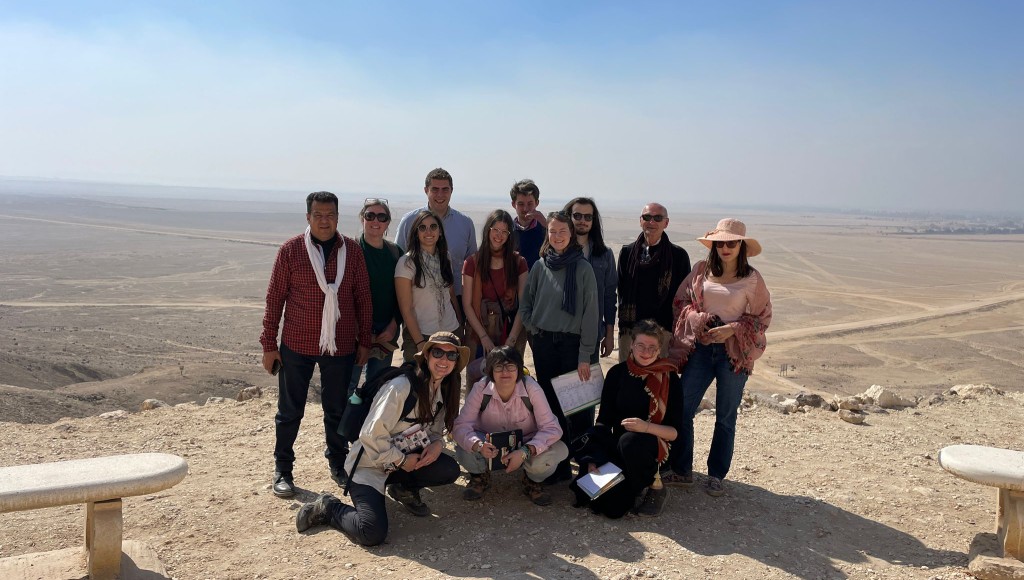Week 4: 28 January–3 February
The week began with our journey to Amarna. Our first destination was the North Palace, where Meritaten, eldest daughter of Akhenaten and Nefertiti lived. After briefly touring the palace, we took the bus to the North tombs, where Grace guided us. It was for some of us an emotional experience to see the hymn to the Aten and depictions of royal family, as we have studied them in detail before. The royal tomb and Boundary Stela U were yet another amazing experience. We had lunch at the Amarna guest house – the chicken was delicious! In the afternoon, we went to the small Aten temple, which of course consists more of a reconstruction than the actual temple. At the office of correspondence lay bricks with inscriptions that are still readable!

On Monday we first had an unexpected journey to Zawyet el-Maytin, a visit that was scheduled at the last minute. We visited the excavations of the University of Cologne Project under the direction of Richard Bussmann. The site has burials and settlement layers of all time periods except the Middle Kingdom.

Our next stop was Tuna el-Gebel, a vast necropolis dating from the New Kingdom to the Roman period. Elissa guided us through a huge catacomb for mummified animal burials, primarily ibises and baboons. The rooms filled with ibis mummies were very impressive. On our way back to Minya we made a quick stop to visit Amarna Boundary Stela A. Back at the hotel an amazing towel-origami crocodile awaited me, Gemma and Giulia in our room. Perhaps to say goodbye, as this was our last night in Minya and tomorrow we will travel further to the south, to Luxor.

On our way to Luxor we first stopped at the museum in Mallawi, where, among many others, the objects from the tomb of Henu are on display. It was fascinating to be able to know the full story of the discovery, and see the actual objects. When we arrived in Luxor, some of us went straight to the Abu el-Haggag mosque, while others stayed at the hotel and relaxed.

Our first day in Luxor started off with a hunt for the closest local falafel store to facilitate our daily lunch. Once completed, we travelled to the tomb of Panehsy, hidden between two alabasters shops, where we met with Suzanne Onstine. The original tomb is a nineteenth dynasty decorated rock cut tomb. A significant corridor has been dug underneath it to serve as a burial location for at least 150 individuals. We travelled onwards to the site of Deir el-Medina, a site with a lot of active missions from several countries and universities directed by IFAO’s Cédric Larcher. It was impressive and inspirational to visit several of the missions and learn about their discoveries and accomplishments. After our lunch with some previous students of the Cairo semester (Kiki, Louis-Phillipe and Audrey) we visited several other tombs that were open to the public, the beautiful Ptolemaic temple and the so-called ‘Big Pit’, the name of which is definitely not an exaggeration.

On Thursday we were lucky to be guided at Medinet Habu by Brett McClain from the Chicago House epigraphic mission. It was a rather cold day, and we laughed a good deal when people relocated towards the sun, rather than staying in the shadows. Evidence for damnatio memorae of Hatshepsut by Thutmosis III was definitely a highlight, along the different layers of graffiti from different periods which were revealed thanks to D-Stretch. In the afternoon we went to Deir el-Bahari. The birth scenes, a rather rare series of scenes in ancient Egyptian art, are depicted on the walls of her mortuary temple. The tourists drove us crazy!

Finally Friday, we had a day to ourselves. Annely and Eva went for a nice and quite exciting horse ride through the village, surrounding fields and the desert. Johan and Giulia stayed at the hotel and the others went to visit the Valley of the Queens, with as a highlight the tomb of Nefertari, with its vivid colors as if it was painted yesterday. It was a good day to catch up with friends and family members after a couple of intensive days.

On Saturday, at seven in the morning we drove into the desert in 4x4’s to pay a visit to the Western Wadi project under the direction of Piers Litherland. We saw the presumable tomb of Thutmose II that was announced last year, and the work in progress to restore its decoration and finds. We only had our breakfast afterwards, but the site was worth it! Next on our program was the Valley of the Kings and we went straight to the stunning tomb of Seti I. Followed by the tombs of Thutmose IV, Tutankhamun and Merenptah. After a short drive outside of the valley we visited the tomb of Ay. But that was not the last tomb of the day, certainly not: we went on to the tombs of the nobles at Shaykh ‘Abd al-Qurna where Gemma gave her presentation on the tomb of Ramose. Our final visit of this week was the unique tomb of Rekhmire.

Annely Arends & Yagmur Koyuncu

